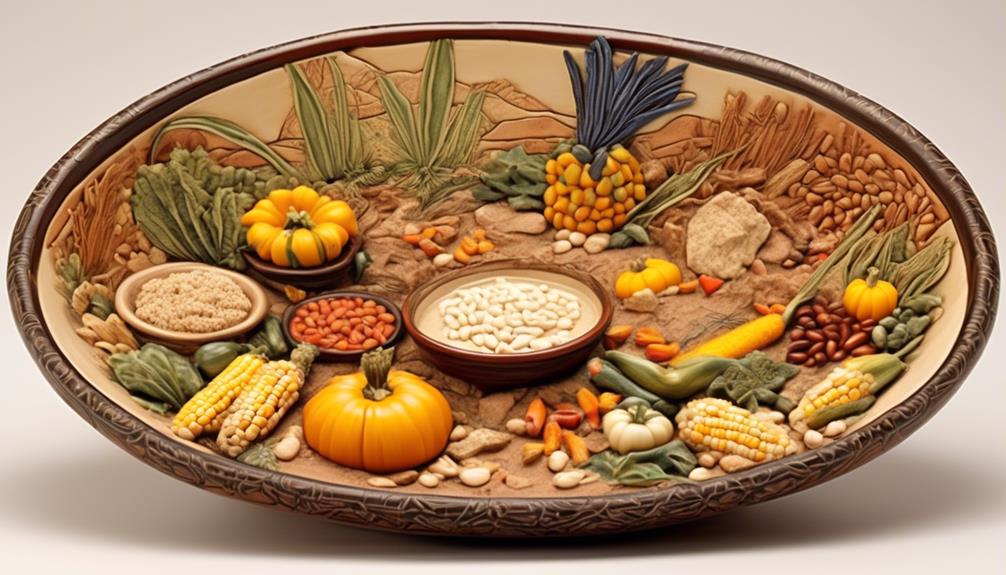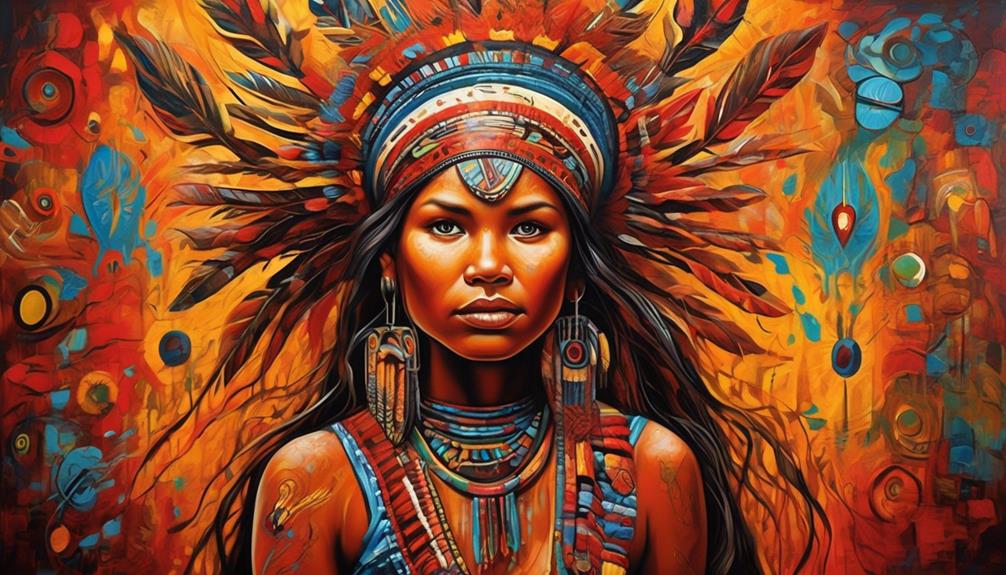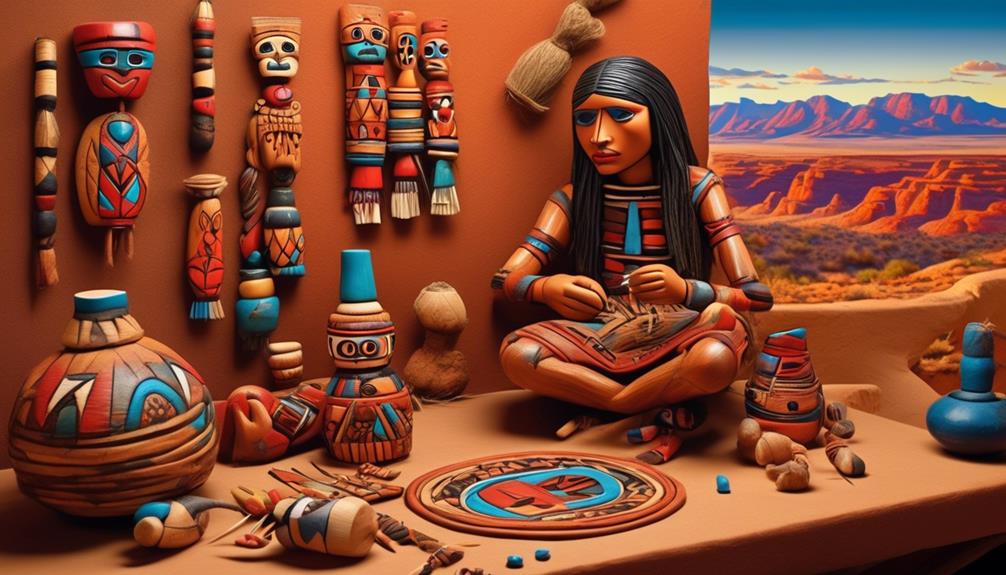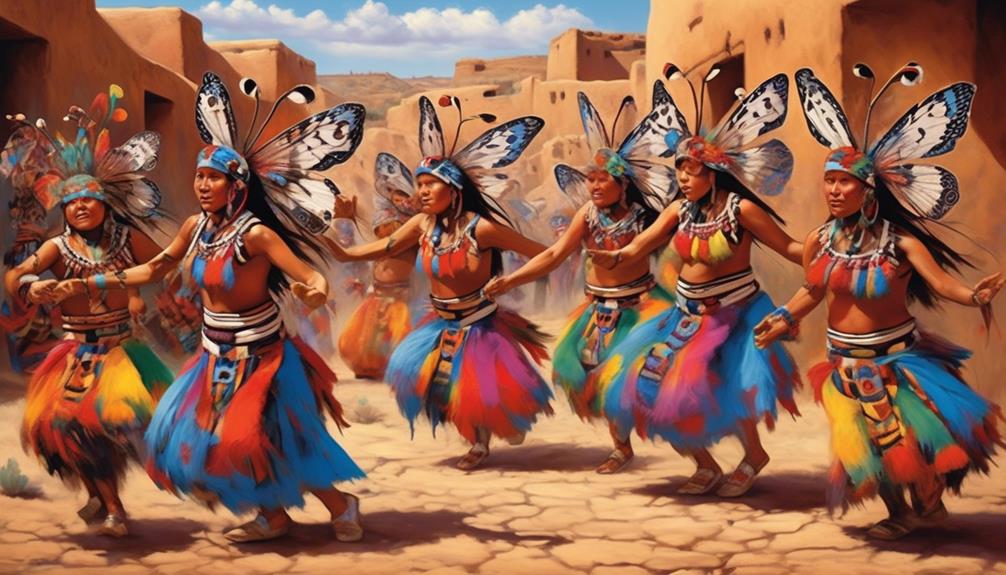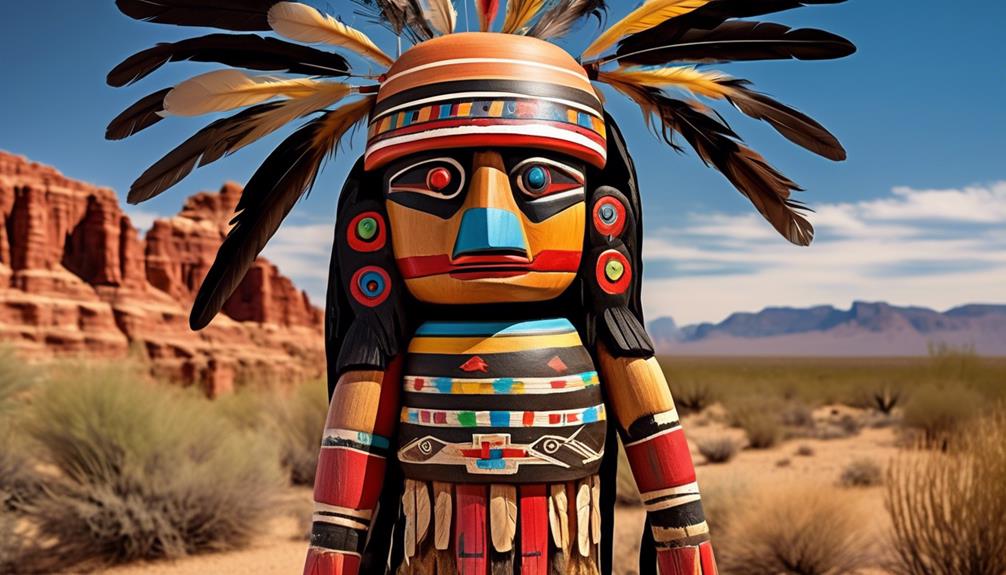The Hopi tribe, much like other Native American communities, had a varied and healthy diet that was closely tied to their farming traditions. For example, the Hopi people grew a range of crops including corn, beans, and squash, which were collectively referred to as the ‘Three Sisters.’ These crops were not only crucial for survival but also carried great cultural and spiritual significance for the tribe.
However, the intricacies of their food gathering, cooking methods, and the spiritual significance of their diet are often overlooked. Understanding the culinary traditions of the Hopi tribe provides a fascinating insight into their rich cultural heritage and the sustainable practices that sustained their communities for generations.
Key Takeaways
- The Hopi tribe practiced advanced sustainable farming methods for arid regions, including terraced fields and dry farming techniques.
- The staple foods in the Hopi diet include maize (corn), beans (especially tepary beans), and squash, which are deeply embedded in cultural and spiritual practices.
- The Hopi tribe employed handpicking, digging, and specialized tools for gathering wild plants, seeds, and herbs, and practiced seasonal harvesting and food conservation.
- The Hopi tribe had unique culinary traditions, such as clay pot cooking, piki bread making, and pit roasting of meats, which were important in preserving cultural identity and heritage.
Hopi Agriculture and Farming Practices
The Hopi tribe practiced a sustainable and sophisticated agricultural system, utilizing terraced fields, dry farming techniques, and a diverse range of crops. Traditional farming methods were integral to their sustainable agriculture, allowing them to thrive in the arid desert environment of the American Southwest.
The terraced fields, known as 'farming steps,' were constructed to make the most efficient use of water in this dry region. These steps not only helped retain moisture but also prevented soil erosion, showcasing the Hopi's deep understanding of the land and its resources.
Dry farming techniques played a crucial role in the Hopi agriculture, as they relied on capturing and retaining what little rainfall the region received. This method involved creating small, shallow basins to collect water and moisture for the crops.
Additionally, the Hopi people cultivated a diverse range of crops, including corn, beans, squash, and melons, among others. This diversity not only provided nutritional security but also contributed to the overall health of the agricultural ecosystem.
Comparatively, the Hopi's sustainable agricultural practices were highly advanced for their time, showcasing a profound understanding of their environment and a deep respect for the land. These traditional farming methods could offer valuable insights for modern agricultural sustainability in arid regions around the world.
Staple Foods in the Hopi Diet

Utilizing their deep agricultural knowledge, the Hopi tribe cultivated a variety of staple foods that formed the foundation of their diet, sustaining them in the arid desert environment of the American Southwest. The Hopi cuisine, characterized by its reliance on traditional recipes, revolved around these staple foods, which weren't only a source of sustenance but also deeply embedded in their cultural and spiritual practices.
- Maize (Corn): Corn was a central component of the Hopi diet, used in various forms such as cornmeal, hominy, and as a primary ingredient in many traditional dishes. It wasn't only a dietary staple but also held significant cultural and ceremonial importance.
- Beans: The cultivation of beans, particularly tepary beans, was integral to the Hopi diet. These nutrient-dense legumes provided essential proteins and complemented the carbohydrates from corn, offering a balanced nutritional profile.
- Squash: Squash, including varieties like yellow and green summer squash, as well as winter squash such as pumpkin, played a crucial role in the Hopi cuisine. Its versatility allowed for diverse culinary applications, contributing to the richness and diversity of their traditional recipes.
The combination of these staple foods not only provided the necessary sustenance for the Hopi people but also reflected the deep connection between their diet, agricultural practices, and cultural traditions.
Gathering and Harvesting Techniques
Drawing from their deep agricultural knowledge, the Hopi tribe employed traditional techniques to gather and harvest the staple foods that formed the foundation of their diet. Gathering techniques were crucial for procuring wild plants, seeds, and herbs. The Hopi people utilized a variety of methods such as handpicking, digging, and using specialized tools like planting sticks and seed beaters. These techniques weren't only practical but also sustainable, allowing the Hopi to maintain a balanced ecosystem while meeting their nutritional needs.
Seasonal harvesting practices were central to the Hopi way of life. The tribe's agricultural calendar dictated when and how certain foods were harvested. For instance, during the summer, the Hopi gathered various wild fruits, nuts, and seeds, while in the fall, they harvested crops like corn, beans, and squash. This seasonal approach ensured that the Hopi people worked in harmony with nature, utilizing the land's resources at the most opportune times.
Additionally, these practices allowed for the conservation of food supplies, ensuring that the tribe had enough to sustain themselves throughout the year. The Hopi's gathering and harvesting techniques exemplify their deep understanding of the land and their commitment to sustainable living.
Culinary Traditions and Cooking Methods
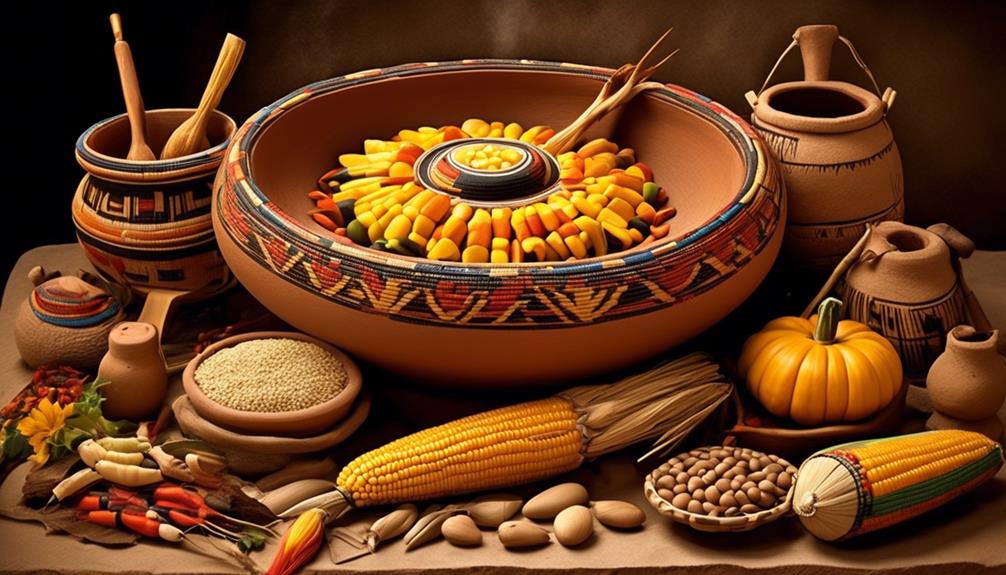
Employing traditional cooking methods and culinary practices, the Hopi tribe crafted a diverse and flavorful cuisine deeply rooted in their cultural traditions and agricultural heritage. Traditional recipes were passed down through generations, reflecting the tribe's close connection to the land and their agricultural lifestyle. Food preparation wasn't just a means of sustenance but also a ceremonial and social activity, with each step holding cultural significance.
- *Clay Pot Cooking:* The Hopi tribe utilized clay pots for cooking, allowing for slow and even heat distribution, which enhanced the flavors of their dishes.
- *Piki Bread Making:* Piki bread, a thin, paper-like bread, was made by spreading a batter of blue cornmeal and water on a hot stone. This intricate process required skill and precision, and the resulting bread was central to many Hopi ceremonies.
- *Pit Roasting:* Meats such as rabbit, deer, and wild turkey were pit-roasted. The meat was seasoned with local herbs and spices, wrapped in corn husks, and cooked in earthen pits, infusing it with a smoky, earthy flavor.
These cooking methods and culinary traditions not only sustained the Hopi tribe but also played a vital role in preserving their cultural identity and heritage.
Spiritual and Cultural Significance of Food
Rooted in our ancestral traditions and agricultural practices, the culinary creations of the Hopi tribe held not only sustenance but also spiritual and cultural significance, weaving a tapestry of meaning into each meal. Food rituals and traditional ceremonies were integral to our daily lives, infusing our sustenance with symbolism and connecting us to our land, ancestors, and deities. Each ingredient and dish carried deep significance, reflecting our reverence for the earth and the spiritual forces that sustained us.
| Food Rituals | Cultural Significance |
|---|---|
| Corn Pollen Sprinkling | Symbolizes fertility, abundance, and gratitude |
| Piki Bread Baking | Honors the artistry and skill of our ancestors |
| Bean Sprouting | Represents growth, renewal, and the cycle of life |
During traditional ceremonies, such as the Niman Kachina ceremony and the Powamu ceremony, specific foods were prepared and consumed with great reverence, marking the cyclical rhythms of our agricultural calendar and invoking blessings for the community. These rituals reinforced our interconnectedness with nature and the spiritual realm, fostering a deep appreciation for the sustenance that sustained both our bodies and souls.
Frequently Asked Questions
What Are the Traditional Hopi Methods for Preserving and Storing Food?
We use traditional preservation and storage methods to adapt to seasonal changes and environmental conditions. It's essential to understand the techniques that best suit our needs.
How Did the Hopi Tribe Adapt Their Diet to Different Seasons and Environmental Conditions?
We adapted our diet to different seasons and environmental conditions by employing various food preservation techniques and unique food items in the Hopi diet. Our adaptation strategies were crucial in overcoming environmental challenges and seasonal variations.
Gender roles in food preparation also played a significant role in our traditional food rituals.
The cultural significance of food was deeply ingrained in our community, shaping our diet and reinforcing our connection to the land.
What Roles Did Men and Women Have in the Preparation and Consumption of Food in the Hopi Tribe?
In the Hopi tribe, men and women had distinct roles in food preparation and consumption. Men were responsible for hunting and farming, while women gathered and prepared food.
During the winter, men focused on hunting game, while women preserved and stored food for the lean months. In the summer, women harvested and processed crops, while men assisted with irrigation.
This division of labor ensured a balanced and sustainable approach to food production and consumption.
Did the Hopi Tribe Have Any Specific Rituals or Ceremonies Related to Food and Eating?
We'll delve into the Hopi tribe's food rituals and traditions.
Ritual feasts were an integral part of Hopi culture, often involving communal meals and ceremonial fasting. These feasts played a vital role in strengthening community bonds and honoring spiritual beliefs.
The preparation and consumption of food were intertwined with their religious practices, reflecting a deep connection between sustenance and spirituality.
Additionally, ceremonial fasting was commonly practiced as a form of spiritual purification and connection with the divine.
What Are Some Lesser-Known or Less Commonly Consumed Foods in the Traditional Hopi Diet?
Forgotten ingredients and seasonal adaptations play a significant role in the traditional Hopi diet. Some lesser-known foods include sumac berries, amaranth, and chia seeds. These ingredients were essential for their nutritional value and cultural significance.
Seasonal adaptations allowed the Hopi to incorporate a variety of wild plants and game into their diet. The diverse range of foods reflects the Hopi's deep connection to their environment and their ability to thrive in challenging conditions.
Conclusion
In conclusion, the Hopi tribe's diet was rich in nutritious and sustainable foods, cultivated through their deep connection to the land.
Like the seeds they planted, their traditions and culinary practices have been passed down through generations, nourishing both body and spirit.
The Hopi people's reverence for the earth and their commitment to preserving ancient farming methods serve as a reminder of the importance of honoring our roots and respecting the gifts of nature.
Mary is a passionate writer who brings creativity and a fresh perspective to our team. Her words have the power to captivate and inspire, making her an essential contributor to our content. Mary’s commitment to storytelling and dedication to promoting Indigenous culture ensures that her work touches the hearts of our readers. We’re fortunate to have her as part of our team.
